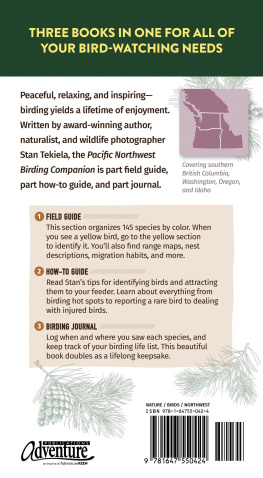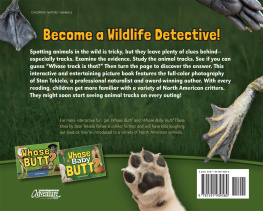

DEDICATION
To the memory of my mother, Adele.
Edited by Brett Ortler and Dan Downing
Cover, book design and illustrations by Jonathan Norberg
Cover photos by Stan Tekiela. Front: White-breasted Nuthatch Back: House Finch
All photos by Stan Tekiela except (juvenile) by Brian K. Wheeler
To the best of the publishers knowledge, all photos were of live birds. Some were photographed in a controlled condition.
10 9 8 7 6 5 4 3 2 1
Stan Tekielas Birding for Beginners: Pacific Northwest
First Edition 2020
Copyright 2020 by Stan Tekiela
Published by Adventure Publications
An imprint of AdventureKEEN
330 Garfield Street South
Cambridge, Minnesota 55008
(800) 678-7006
www.adventurepublications.net
All rights reserved
Printed in the United States of America
ISBN 978-1-64755-121-6 (pbk.); ISBN 978-1-64755-122-3 (ebook)
Table of Contents
Getting Started
Welcome to the world of birding! If youre a beginner trying to identify the birds in your backyard, this book is for you. Birding is a simple pastime thats incredibly popular, and its not hard to see why: You can watch birds in any season, and as far as hobbies go, a basic setup is about as cheap as it gets. All you need is some green space, a bird feeder and perhaps a pair of binoculars. Ive written this book to help birders who are just starting out. This book contains 57 species of birds in the Pacific Northwest all common backyard visitors. It includes summertime favorites such as orioles, bluebirds and hummingbirds and year-round residents such as quails, chickadees and nuthatches. The birds I chose for this book are among the most common and familiar visitors to backyard feeders.
Once you start identifying backyard birds, Id encourage you to find my state-specific field guide for your state. Ive written guides for each state in the Pacific Northwest, and each book contains around 130 species, including a wide variety of birds youre not as likely to see in your average backyard, including raptors, shorebirds and more. It also contains a detailed range map for each species, showing when and where each bird is usually found.
I sincerely hope you enjoy your start to bird watching. Have fun, and again, welcome!


Rufous Hummingbird female
Bird Feeder Basics
To get more birds to visit your yard, an easy way to invite them is to put out bird feeders. Bird feeders are often as unique as the birds themselves, so the types of feeders you use really depends on the kinds of birds youre trying to attract.

Hopper feeders are often wooden or plastic. Designed to hold a large amount of seeds, they often have a slender opening along the bottom, which dispenses the seeds. Birds land along the sides and help themselves to the food. Hopper feeders work well as main feeders in conjunction with other types of feeders. They are perfect for offering several kinds of seed mixes for grosbeaks, finches, nuthatches, chickadees and more.

Tube feeders with large seed ports and multiple perches are very popular. Often mostly plastic, they tend to be rugged enough to last several years and can be easily cleaned. These feeders are great for black oil sunflower seeds and seed mixes, which are favorites of grosbeaks and all the other bird species that also visit hopper feeders.
Some tube feeders have small holes, allowing incredibly tiny thistle seeds to be dispensed just a few at a time. Use this kind of feeder to offer Nyjer seed, which will attract various finches.
Other styles of tube feeders have a wire mesh covering with openings large enough for birds to extract one of their favorite foodspeanuts out of the shell. Most birds enjoy peanuts, so these feeders will be some of the most popular in your yard. Another variety of tube feeder has openings large enough for peanuts in the shell. These are also very popular with the birds.

Ground feeders allow a wide variety of birds to access the food. The simplest and easiest feeders to use, they consist of a flat platform with a lip around the edges to keep seeds from spilling out. Some have a roof to keep rain and snow off the food. With or without a roof, drainage holes in the bottom are important. Ground feeders will bring in juncos and many other birds to your backyard, even California Quail.

Suet feeders are simply wire cages that hold cakes of suet. The wire allows woodpeckers, nuthatches and other birds to cling securely to the feeder while pecking out chunks of suet. The best suet feeders have a vertical extension at the bottom where a woodpecker can brace its tail and support itself while feeding. These are called tail-prop suet feeders.

Nectar feeders are glass or plastic containers that hold sugar water. These feeders usually have plastic parts that are bright red, a color that is extremely attractive to hummingbirds, but orioles and woodpeckers will also stop for a drink. They often have up to four ports for access to the liquid and yellow bee guards to prevent bees from getting inside.

Mealworm feeders can be very basica simple glass or plastic cup or container will do. Pick one with sides tall enough and make sure the material is slippery enough to stop the lively mealworms from crawling out. Bluebirds especially love this wiggly treat!
Get to Know Your Birdseed

Black Oil Sunflower: Studies have shown that all birds prefer black oil sunflower seeds over all other commercial bird foods. Black oilers are smooth black seeds that come from the common sunflower plant, Helianthus annuus . Even smaller birds such as finches have no trouble cracking open these seeds with their large, strong bills.
Next page




























